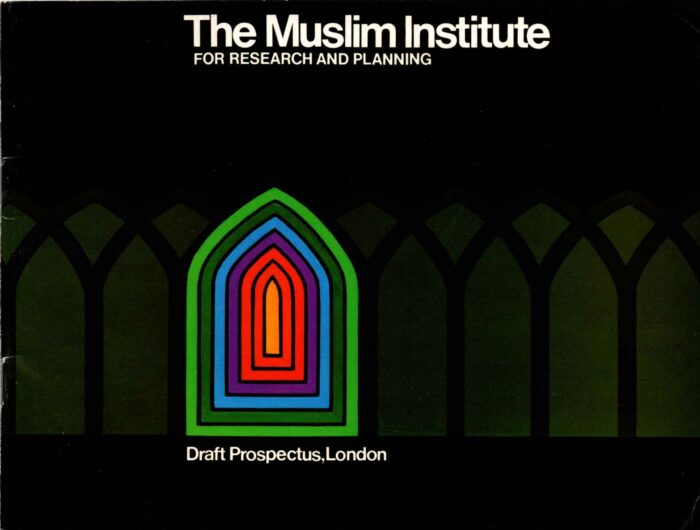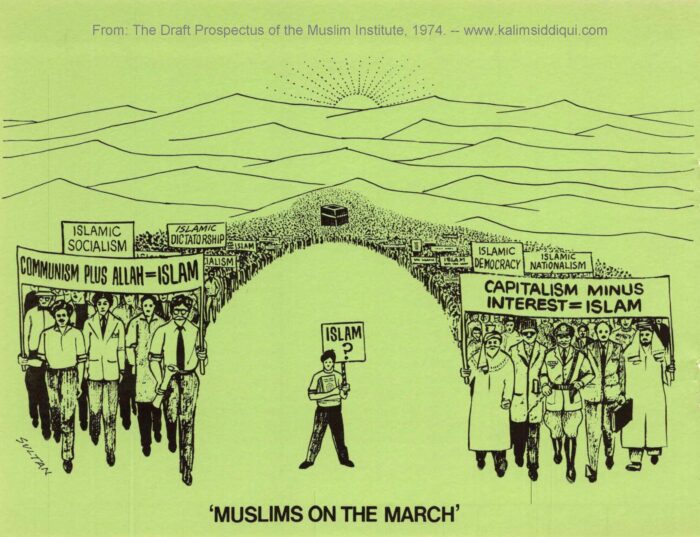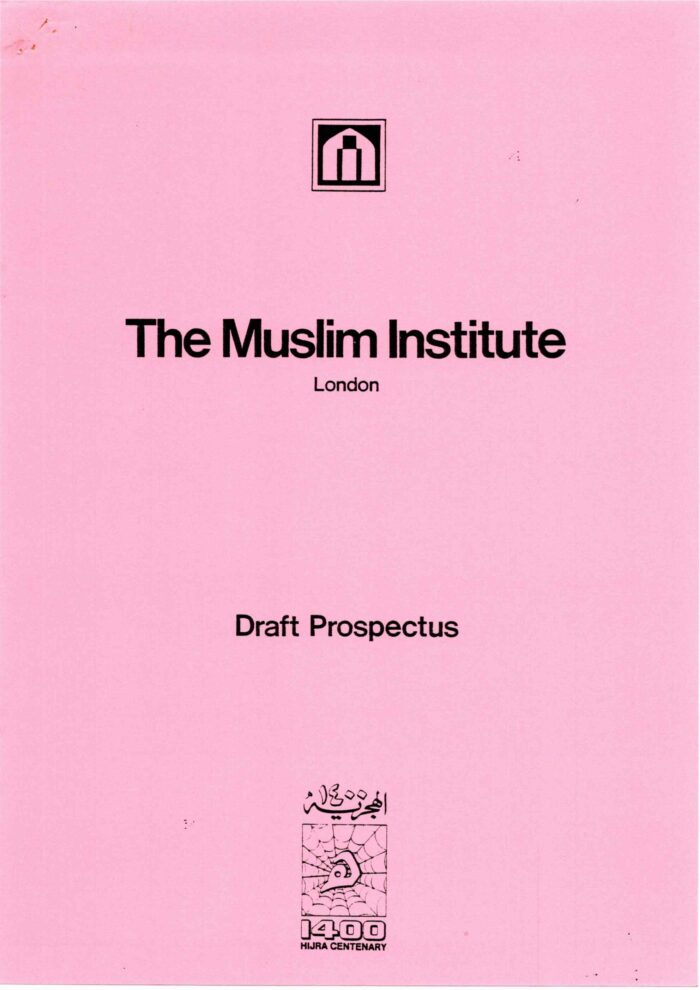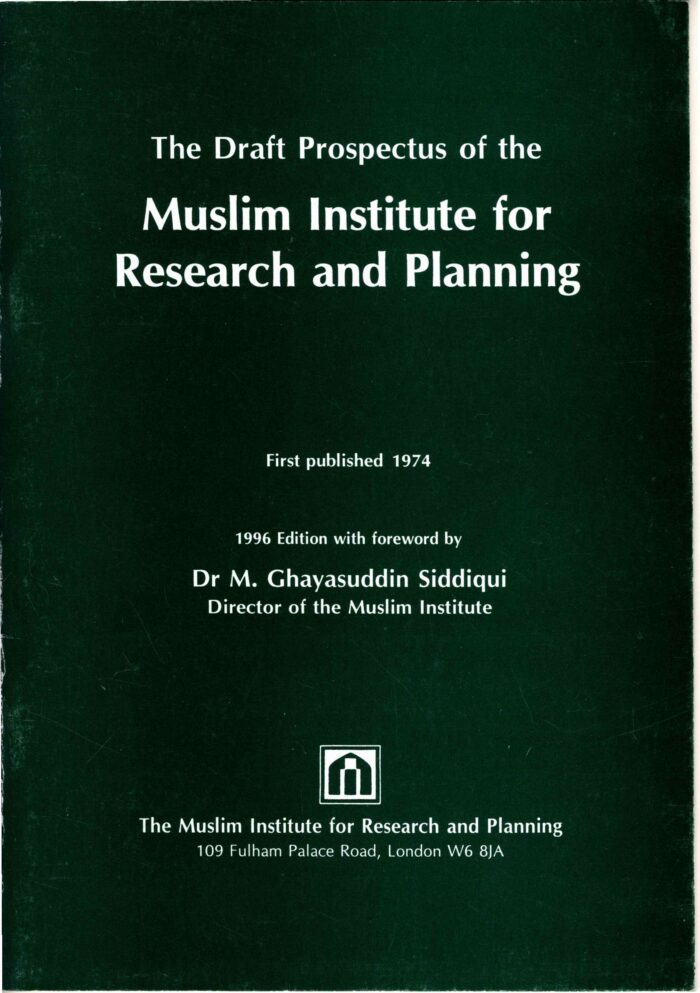
This page provides an introduction to the Draft Prospectus of the Muslim Institute, along with links to PDF versions of its various editions between 1974 and 1996. For the simple text of the Draft Prospectus, see this page.
The Draft Prospectus of the Muslim Institute was the founding document of the Muslim Institute, published in 1974. The Muslim Institute emerged from a series of discussions among a group of young Muslims in the UK that began on the subject of Pakistan, and then expanded in scope to consider the Muslim world as a whole. A number of documents were prepared and discussed in this process, all written by Dr Kalim Siddiqui. The Draft Prospectus was the culmination of this collective process of self-examination and contemplation.
In his foreword to the 1996 reprint of the Draft Prospectus (see links below), Dr M. Ghayasuddin Siddiqui wrote that
Although this document was published in the name of the Preparatory Committee, it was in fact almost entirely the work of Dr Kalim Siddiqui. […] Dr Kalim Siddiqui was a very organised and methodical man. He would go on producing draft after draft of a document until a consensus had been reached and no more improvements could by made.
A more detailed account of the origins of the Muslim Institute and the writing the the Draft Prospectus is given by Imam Zafar Bangash, who was one of the original members of the Preparatory Committee. In his introduction to the volume of Dr Kalim Siddiqui’s writings that had been published earlier in 1996 (and which is the essential starting point for any deeper understanding of Dr Kalim Siddiqui’s life and work), Imam Bangash wrote that:
Thereafter, Dr Siddiqui turned his attention to preparing the Draft Prospectus of the Muslim Institute. No other document, at least in my life experience, has been so thoroughly debated and discussed as the Draft Prospectus before its final version was approved by what came to be called the Preparatory Committee. Dr Siddiqui was generous in calling the Draft Prospectus the product of the collective effort of the Preparatory Committee; in fact it was almost entirely his own work. […] This process lasted from July 1973 to February 1974 when the final version of the Draft Prospectus was approved.
At the core of the Draft Prospectus is the essay ‘A Strategy for Change’. This lays out the basic understanding and consensus on the basis of which the Preparatory Committee set out to build the Muslim Institute.

This consensus can be summarised as an acknowledgement that Muslims had failed on the stage of history, resulting in the catastrophic decline of Islamic civilization relative to the West; and a confident expectation that Islamic civilization would re-emerge in due course, even though it was bound to take a very long time. The task that the Muslim Institute took on, therefore, was to lay the groundwork for this future re-emergence, even though the fruit of this work might not be seen within the lifetimes of even the younger members of the Preparatory Committee. Thus, the Draft Prospectus says,
The MUSLIM INSTITUTE is, and must be, part of a strategy of social action which should ultimately lead to the restructuring of the entire socio-economic and political systems in Muslim societies throughout the world. The MUSLIM INSTITUTE, therefore, cannot be more than a necessary first step towards that goal. Indeed, progress towards the goal is certain to be uneven in time and space. It may well be that a model society will have to be created and developed in one geographical area before the pace of change can be accelerated in other areas. […]
The MUSLIM INSTITUTE is a small but necessary first step in the long road to recovery that lies ahead.
It is sometimes suggested that Dr Kalim’s response to the Islamic Revolution in Iran was a radical break from the work of the Muslim Institute before that time. In fact, reading the Draft Prospectus now, as well as other writings of Dr Kalim in the 1970s, such as Beyond the Muslim Nation-States (1976) and The Islamic movement: a systems approach (1977), it is clear that the work of the Institute was understood from the outset as part of a historical project of socio-political change. The initial emphasis on academic and intellectual work was simply because there was no expectation at that stage that any political breakthrough was possible in the near future.
This pessimistic outlook that was confounded by the Islamic Revolution in 1978-79, and the unexpectedly quick change in the historical situation prompted Dr Kalim Siddiqui to change the emphasis of the Institute’s work, within the overall historical understanding articulated in the Draft Prospectus. Thus in a review of the Muslim Institute’s progress published in early 1979 – as the Revolution was still in its earliest stages – Dr Kalim wrote that
The historical situation has been transformed by the Islamic Revolution in Iran. Suddenly the global Islamic movement has a success story to tell. The revolution in Iran has also transformed the climate of opinion and expectations of the thousand million Muslims of the world. The Islamic movement has perhaps achieved the vital breakthrough that was essential to bring us out of the post-colonial confusion and apologia. The future now has a new and hopeful dimension which seemed remote only a short while ago.
Editions of the Draft Prospectus
The Draft Prospectus of the Muslim Institute was originally published in 1974, at the earliest stage of the Institute’s development, as a deliberately impressive, glossy document with a simple but superbly effective graphic design. This was designed both to reflect the ethos of the project and to impress potential founders, supporters and donors. The layout was designed by Sultan Farooqui, an artist and poet who was a close friend of Dr Kalim Siddiqui, and who would do most the Institute’s graphic design work through to the logo, letterhead and publications of the Muslim Parliament in the 1990s. (It is worth noting that this was long before the age of computers and digital design, when this was a much more specialist task than it is now.)

When copies of the glossy Prospectus began running out in about 1977, it was replaced by a much simpler edition that consisted of A4 sheets stapled together, with pink front and back covers. Still in the pre-computer era, the layout of this edition was designed by sections of the original glossy Prospectus being literally cut up and pasted onto A4 sheets of paper. It is a tribute to the simplicity and effectiveness of Sultan Farooqui’s original design that the document still looks impressive in this improvised layout. This version was reprinted repeatedly over the next 15 years, with minor changes to the design, through the busiest section of the Institute’s history. However, other documents came to the fore as more current expressions of the Institute’s outlook and work.
Following Dr Kalim Siddiqui’s death is 1996, and shortly before the Kalim Siddiqui Memorial Conference in November that year, the Draft Prospectus was re-issued with a Foreword by his successor as Director of the Muslim Institute, his former assistant Dr M. Ghayasuddin Siddiqui. This Foreword also put the work of the Institute over the previous 20 years in the context of the vision set out in 1974:
The victory and consolidation of the Islamic Revolution in Iran, and the subsequent emergence of a global Islamic movement, have re-written the timescale for the re-emergence of Islamic civilization envisaged by the Muslim Institute in the 1970s. But many of the questions raised then still remain to be addressed, let alone answered.
Unfortunately, under this new management, the Muslim Institute was not long to survive after Dr Kalim’s death. Those of his associates who remained committed to his vision and legacy established the Institute of Contemporary Islamic Thought (ICIT) in 1998, under the leadership of Imam Zafar Bangash. This continues to work on the basis of the vision first laid out in the Draft Prospectus of the Muslim Institute almost 50 years ago.

